With thanks to the website © Rennes‑le‑Chateau‑archive.com and its owner for permission to translate this article.
While studying the idea of the sword representing a Meridian i came across a French researcher who suggests that not only is the sword representing one Meridian, but probably THREE - as represented by the design of the sword by Philippe de Cherisey on the cover of his novel CIRCUIT - where he is using three lines to outline a sword overlaying an image of the country of France!
(The researcher is Jean-Pierre GARCIA and his ideas are worth getting to know. His ideas involve the somewhat esoteric nature of French history and its Sacred Geometry and Meridians. With the permission of Jean-Pierre GARCIA i have published here some of the relevant illustrations as well as his ideas [in translation] as below;
The sword [glaive, from Middle English glaive (“weapon with a long shaft ending in a point or blade; lance, spear”), from Old French glaive (“lance; sword”). Further etymology is uncertain; one possibility is that the Old French word is from Latin gladius (“sword” Roman short sword, gladius”). Doublet of glaive while another is that it derives from Proto-Celtic *kladiwos (“sword”), with both ultimately from Proto-Indo-European *kelh₂- (“to beat; to break”). Or another word, L’épée (du latinspatha, « chose plate ») est une arme blanche à double trenchant - that is - sword (from the Latin spatha "flat thing") is a double-edged bladed weapon] of the marquis is depicted on a famous document by Philippe de Cherisey which serves as the cover for his novel CIRCUIT.
We see the simplified map of France, crossed by a Merovingian sword and superimposed with the Seal of Solomon , the famous 6-pointed star made up of 2 inverted equilateral triangles. This sword is reminiscent of a certain "dead sword", the famous " MORTEPEE " key used to decrypt the Large Parchment. Is it 'sword overload' for Cherisey on a rather strange drawing?
 Cover drawing of the magazine CIRCUIT, annotated October 1971 and deposited in 1967 at the Library of Versailles by Philippe de Cherisey, who died in 1985
Cover drawing of the magazine CIRCUIT, annotated October 1971 and deposited in 1967 at the Library of Versailles by Philippe de Cherisey, who died in 1985
The first observation that comes to mind is the geographic relevance of such a representation. Is it a simple sketch laid out so as to show a few symbols? Or do the contours of the sword and the star provide real information around a few meridians, all verifiable on a map? Above all, is there a link with lesser-known historical meridians....?
If we admit that the central line of the sword actually shows three meridians, the problem is therefore to position them on an unambiguous map. However, a first indication is given to us clearly: the central line passes through a town - Saint-Ursine. La ‑ Chapelle ‑ Saint ‑ Ursin is a small French commune located in the department of Cher and the Centre region. Surrounded by Morthomiers, Saint-Doulchard and Trouy, La-Chapelle-Saint-Ursin is 6km southwest of Bourges which is the largest city in the area and especially the former capital of France.
Now let's draw its meridian ...
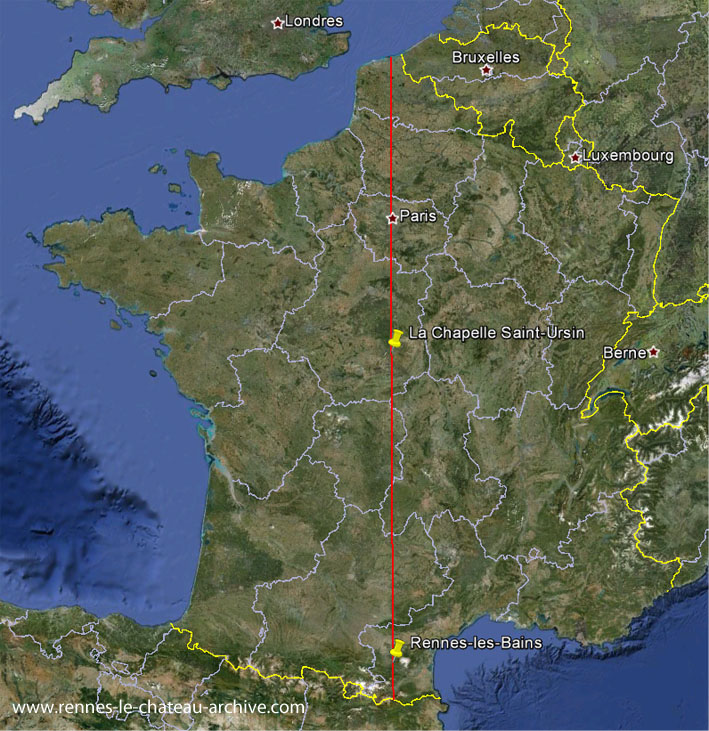 The central line of the Cherisey sword passes through La Chapelle Saint ‑ Ursin, through Paris and through Rennes ‑ les ‑ Bains (Google Earth)
The central line of the Cherisey sword passes through La Chapelle Saint ‑ Ursin, through Paris and through Rennes ‑ les ‑ Bains (Google Earth)
Here is therefore a first result: the central line of the sword passes through Paris and very exactly through Rennes-les-Bains. Here is what certainly interested Philippe de Cherisey, but what path did he follow to reach Saint ‑ Ursin? Is the drawing in fact a document from an older source or was it composed by the Marquis de Cherisey?
Note that the 0 meridian is very close since it passes 1200m east of the Saint-Ursine meridian. La Chapelle Saint-Ursin has another feature closely linked to the Serpent Rouge of Pierre Plantard. Indeed, Théophile Moreux (1867‑1954), astronomer, director of the Bourges observatory and populariser, attended primary school at La Chapelle Saint ‑ Ursin and his father was a teacher there.
We find on page 2 of Plantard's file a quote from Abbé Moreux:
"... After a long sleep, the same hypotheses come back to life, no doubt they come back to us with new and richer clothes, but the background remains the same and the new mask with which they are adorned cannot deceive the man of science..."
Abbé Th. Moreux
Director of the Bourges Observatory, page 10, from the book "L'Alchimie moderne"
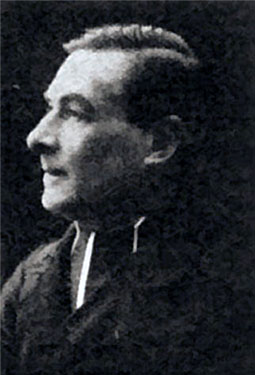
Now let's move on to the east and west threads of the sword. It is easy to see that the eastern line passes very exactly over the southern French-Spanish border point, near Banyuls-sur-Mer, at Cerbère, and not far from Argelès. To the north, it crosses Roubaix. This meridian is 69,245 m from the central meridian.
By a simple vertical symmetry we can deduce the West meridian. Coincidentally (one more) this West meridian passes through Les Andelys, the birthplace of Nicolas Poussin and through Chartres and its cathedral , where we find a sculpted representation of the Ark of the Covenant ...
The meridian of the eastern sword is at: 3 ° 10 '27.88 "E
The meridian of the West sword is at: 1 ° 28 '02.73 "E
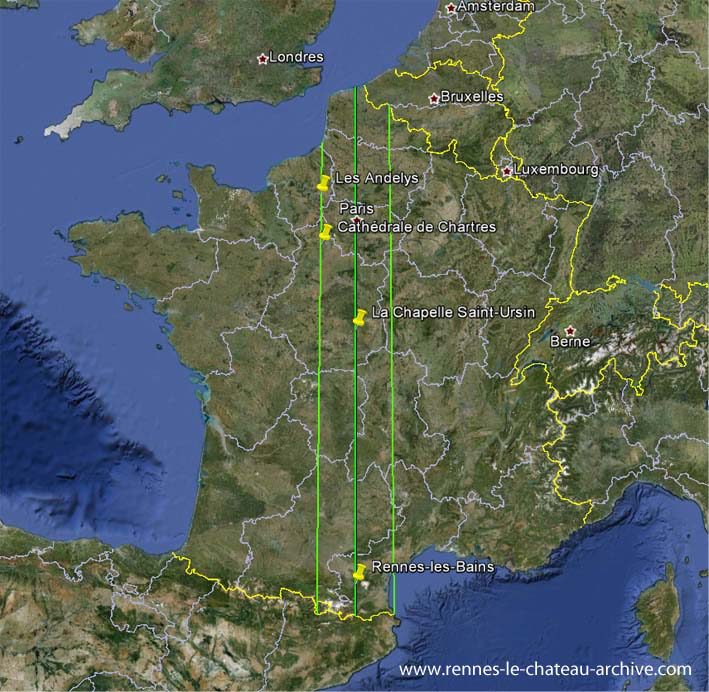
The meridians of the Cherisey sword ... Its central meridian is very close to the 0 meridian (Google Earth)© Rennes‑le‑Chateau‑archive.com
Another curiosity that should be noted: A drawing visibly inspired by that of Cherisey , was published in the best-selling book " The sacred enigma " by Michael Baigent, Richard Leight and Henri Lincoln . The resemblance ends there, because subtle differences exist. Saint-Ursin has disappeared and the central meridian is placed more to the west. Moreover, while the West meridian is still in its place, the East meridian has slipped towards the East to of course respect the symmetry of the sword.
As for the star, it slipped north because it was slightly enlarged to better mark the borders, all without worrying about Saint-Ursin or any centre ... In short, the design has been transformed by completely neglecting hidden indications, but fundamental as we will see later ...

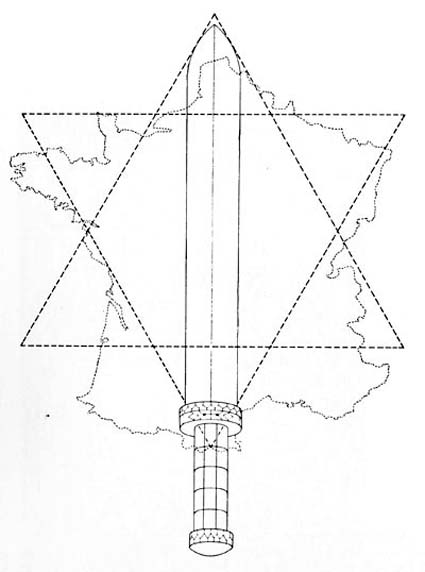
Top - cover drawing of the CIRCUIT magazine (deposited in 1967 at the BN de Versailles by Philippe de Cherisey)
Bottom - Drawing taken from the magazine CIRCUIT and modified. (The sacred enigma of Michael Baigent ‑ Richard Leight ‑ Henri Lincoln)
The differences are all the more astonishing as the drawing is accompanied by a caption " CIRCUIT cover drawing", but the drawing has been completely revised, it is obvious. " The Sacred Enigma " was published in 1982. We can therefore say without much risk that the original is indeed that of Cherisey ... Why has it been changed? Error or manipulation? Saint-Ursin having disappeared, it is very likely that their investigation stopped at the Paris meridian ...
Overlay on the actual map
The drawing turns out to be a particularly well reproduced map. Despite the printing defects and the involuntary deformations that the drawing must certainly have undergone following the various reproductions and prints, Cherisey's map fits perfectly on the Google Earth image.
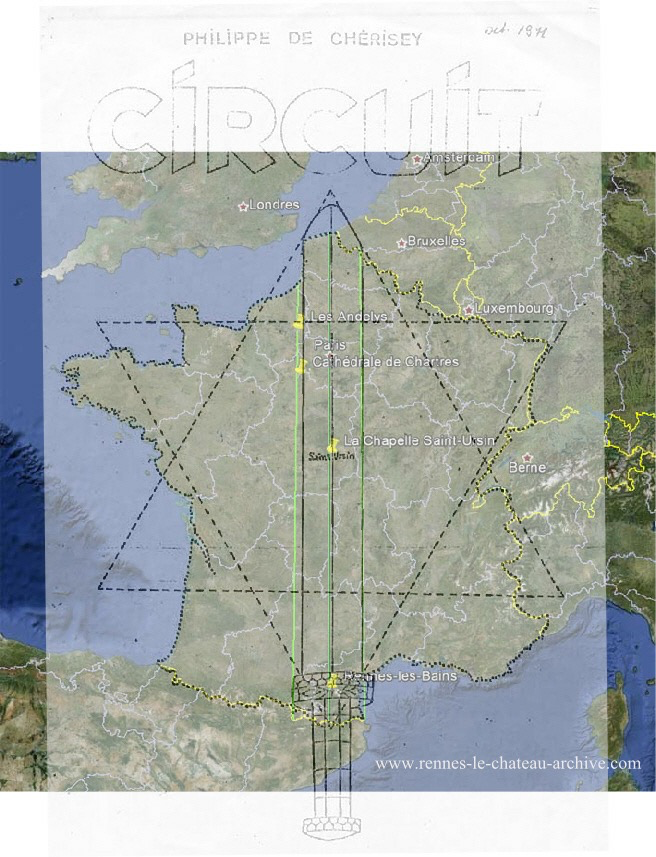 The cross of Cherisey fits perfectly on a real map - © Rennes‑le‑Chateau‑archive.com
The cross of Cherisey fits perfectly on a real map - © Rennes‑le‑Chateau‑archive.com
But we must continue, because this drawing hides many secrets that must be flushed out.
Like a charade in which the first solution has been blown to us, we must progress step by step. The surprises are then there ...
To prove that this drawing has much more to say than you might imagine, let's take a closer look. Assuming that the dimensions of the sword have a specific function, let's draw a square such that its lower side hovers over the lower end of the sword's hilt and such that the left and right sides of the square coincide with the width of the sword. star.
The perfect square then crosses exactly Paris . The high side therefore represents the parallel of Paris used by Cassini to carry out its triangulation, that which is marked by the North-South facade of the Observatory.
Here is a first property that allows us to consider many other discoveries ... Let's continue ...
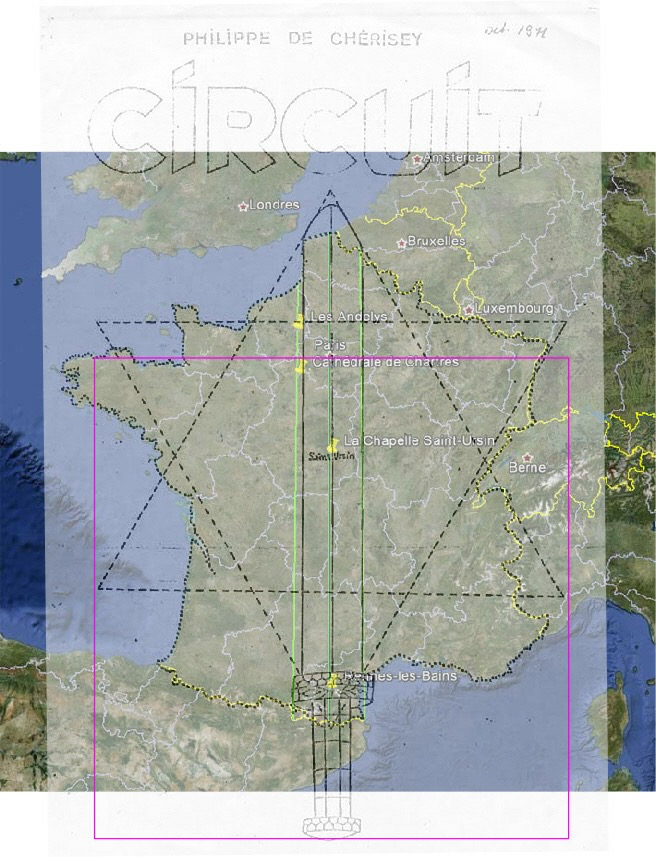 A square bordering the sword at the bottom allows you to cross Paris © Rennes‑le‑Chateau‑archive.com
A square bordering the sword at the bottom allows you to cross Paris © Rennes‑le‑Chateau‑archive.com
Now let's see if this square is placed at any height. After all, the size of the sword could have been calculated so that one side crosses Paris.
Let's determine its center by drawing the 2 diagonals. Another wonder appears. The centre of the square is at the intersection of the Saint-Ursin meridian and the base of the male equilateral triangle (point up).
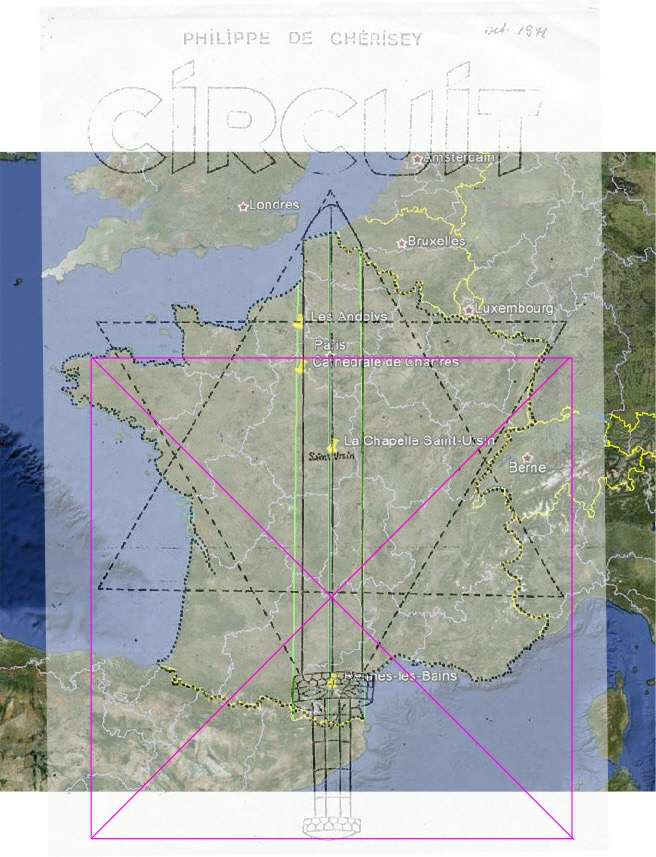 The center of the square coincides with the Saint-Ursin meridian and the base of a triangle © Rennes‑le‑Chateau‑archive.com
The center of the square coincides with the Saint-Ursin meridian and the base of a triangle © Rennes‑le‑Chateau‑archive.com
Marquis de Cherisey had more than one trick up his sleeve. He had understood or he had elements allowing to understand that a very particular geometry could be superimposed on France revealing some secrets. But before going further, it is necessary to approach another meridian, very secret this one ..
 Cover drawing of the magazine CIRCUIT, annotated October 1971 and deposited in 1967 at the Library of Versailles by Philippe de Cherisey, who died in 1985
Cover drawing of the magazine CIRCUIT, annotated October 1971 and deposited in 1967 at the Library of Versailles by Philippe de Cherisey, who died in 1985 The central line of the Cherisey sword passes through La Chapelle Saint ‑ Ursin, through Paris and through Rennes ‑ les ‑ Bains (Google Earth)
The central line of the Cherisey sword passes through La Chapelle Saint ‑ Ursin, through Paris and through Rennes ‑ les ‑ Bains (Google Earth)



 The cross of Cherisey fits perfectly on a real map - © Rennes‑le‑Chateau‑archive.com
The cross of Cherisey fits perfectly on a real map - © Rennes‑le‑Chateau‑archive.com A square bordering the sword at the bottom allows you to cross Paris © Rennes‑le‑Chateau‑archive.com
A square bordering the sword at the bottom allows you to cross Paris © Rennes‑le‑Chateau‑archive.com The center of the square coincides with the Saint-Ursin meridian and the base of a triangle © Rennes‑le‑Chateau‑archive.com
The center of the square coincides with the Saint-Ursin meridian and the base of a triangle © Rennes‑le‑Chateau‑archive.com